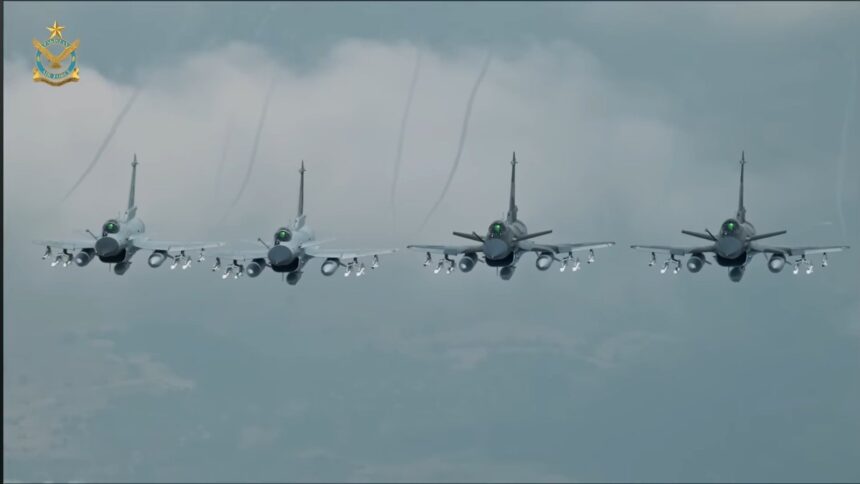Pakistan’s fleet of Chengdu J-10C fighters, operated by the Pakistan Air Force under the local nickname “Indus Dragons,” has been presented as a key air-superiority platform equipped for long-range engagements. The aircraft combines an AESA radar, modern avionics and electronic warfare systems, and a heavy air-to-air loadout—most notably PL-15 beyond-visual-range missiles and PL-10 short-range missiles—integrated into Pakistan’s sensor and command networks to enable stand-off engagements and coordinated operations.
The J-10C platform and role
The J-10C (export designation J-10CE) is a fourth-plus-generation multirole fighter from China’s Chengdu Aircraft Industry Group. In Pakistan service it is positioned primarily for air superiority and defensive counter-air missions. The type features an active electronically scanned array radar, modern avionics including infrared search-and-track and a helmet-mounted sight, and a turbofan engine that improves thrust and climb performance. PAF briefings emphasize the J-10C’s role as the high end of a mixed force structure that includes F-16s and JF-17s.
Weapons fit and combat loadout
PAF J-10Cs are commonly configured for air-to-air dominance, carrying long-range PL-15 missiles on dual ejector racks and short-range PL-10 missiles on the wingtips. The export PL-15 is reported to have an estimated maximum range in the order of 145 kilometers, with domestic variants cited as having significantly greater reach; it uses an active radar seeker, a high-speed motor and advanced counter-countermeasures. The PL-10 is an imaging-infrared, high-off-boresight missile with thrust-vectoring for close-in dogfighting. Dual ejector racks increase payload capacity, allowing multiple long-range missiles to be carried without severely compromising aerodynamics.
Tactics, networking and electronic warfare
Operational doctrine for these J-10Cs emphasizes stand-off engagement, networked targeting, and electronic warfare. The aircraft’s AESA radar and missile suite are intended to permit early detection and beyond-visual-range engagement of hostile aircraft. J-10Cs have been integrated into Pakistan’s broader sensor-shooter architecture via a locally developed data link known as Data Link 17, which is designed to share targeting data with airborne early-warning platforms and other fighters so that individual aircraft can be cued without running their own radars. Complementing this are onboard electronic countermeasure systems that Pakistani sources say are used to complicate adversary situational awareness.
Combat employment and reported engagements
Pakistani officials have attributed successful long-range engagements to the combination of the J-10C airframe, PL-15 missiles, networked sensor data, and electronic warfare measures. In one reported series of aerial engagements, Pakistani authorities said J-10Cs used PL-15 missiles to strike adversary fighters at ranges beyond previously estimated limits, with the strikes described as among the longest-range air-to-air hits recorded. Those accounts characterize the outcome as the result of underestimated missile range, effective data-linked target handoff, and electronic warfare effects; independent verification of specific engagement ranges and outcomes has not been presented in the official statements cited by Pakistani sources.
Technical enhancements and comparisons
PAF sources highlight several enhancements on their J-10C fleet compared with earlier models: dual missile ejector racks that expand long-range missile carriage, the WS-10B turbofan for improved thrust, and the KLJ-10 AESA radar capable of tracking and engaging multiple targets simultaneously. Pakistani commentary contrasts these systems with regional competitors, noting the combination of an advanced radar and long-range missiles as a significant capability multiplier relative to older radar and missile suites on some other aircraft types.
Strategic implications for Pakistan and regional balance
The acquisition and operational use of the J-10C have been framed by Pakistani officials as both a capability upgrade and a deterrent. Officials say the platform complements existing fighter types to create a high-low force mix rather than replace them, while demonstrating deeper defense ties with China and reduced reliance on Western suppliers. Pakistani narratives also suggest that perceived combat success has bolstered confidence in Chinese export platforms and could influence regional procurement and defense calculations.
Prospects and future developments
PAF commentary points to potential further procurements and incremental upgrades. Possibilities discussed include larger fleet numbers over time, improved data-link interoperability, continued sensor upgrades, and changes to missile designs—such as folding fins on long-range missiles for different carriage options. Observers note that combat claims and operational experience will be influential in shaping both Pakistan’s future orders and external interest in Chinese fighter and missile exports.
Conclusion
The Pakistan Air Force’s J-10C fleet is presented by Pakistani sources as a modern air-superiority asset that leverages long-range missiles, advanced sensors and networked operations to prosecute stand-off engagements. Reported combat employment and the platform’s integration into Pakistan’s broader air-defence architecture are described as having strengthened deterrence and underscored China-Pakistan defense cooperation, while prompting attention to how such capability fits into regional aerial warfare balances.











